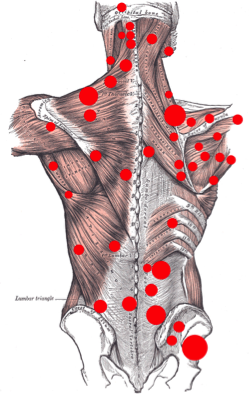Trigger Point Dry Needling
 What are Trigger Points?
What are Trigger Points?
Also known as myofascial trigger points, they are hyperirritable spots in the fascia surrounding skeletal muscle. These palpable nodules are found in taut bands of muscle fibers and consist of “multiple contracted knots”. So, yes, the knots you may feel in your back, for example, truly are knots!
Presence of trigger points are related to the production, continued muscle dysfunction and a pain cycle.
Trigger Point Dry Needling:
Dry needling is a procedure in which a needle is inserted into the skin and muscle directly at a myofascial trigger point. Proper dry needling of a myofascial trigger point will elicit a local twitch response (LTR), which is an involuntary spinal cord reflex in which the muscle fibers in the taut band of muscle contract. This twitch response then results in muscle relaxation due to the release of shortened bands of muscle fibers as well as pain relief by activating endogenous opioids (an analgesic effect using the Gate Control Theory of Pain).
Dry needling that elicits LTRs improves treatment outcomes, as indicated below by the –
American Academy of Orthopedic Manual Physical Therapists (AAOMPT):
Dry needling is a neurophysiological evidence-based treatment technique that requires effective manual assessment of the neuromuscular system. Research supports that dry needling improves pain control, reduces muscle tension, normalizes biochemical and electrical dysfunction of motor end plates, and facilitates an accelerated return to active rehabilitation.
Why TPDN? What does it help?
As we are limited with our hands and fingers, the needling gives us access to the trigger points and deeper muscle layers making this technique superior to other treatment in eliciting a twitch response. Deactivation of the trigger points can bring immediate relief of symptoms.
Trigger point dry needling therapy can help treat the following conditions:
- Myofascial Pain
- Neck and Back Pain
- Headaches
- TMJ/TMD
- Chronic Pain
- Movement Disorders
- Sprains or Strains
- Muscle Imbalances
- Sports Injuries
- Joint Pain of Myofascial Origin
TPDN Treatment:
Dry Needling is best when performed in conjunction with other forms of physical therapy treatment. Such other PT treatments may include exercises, postural training, education, and other hands-on techniques such as myofascial release, deep/soft soft tissue work and manipulation.
The amount of treatment will depend on concurrent medical conditions, on your compliance with the exercises, and your everyday activity level.
What you experience during treatment:
- You may feel a little prick through the skin (however, when the muscle is relaxed, you will not feel the needle at all).
- When the needle touches the trigger point it will elicit a local twitch response. This twitch is very brief and unexpected. It can be momentarily painful.
What you may experience after treatment:
- Muscular soreness following treatment (this discomfort will be lessened by heat and stretching).
- Improved mobility, decreased pain, and on track for improved function and activity!
